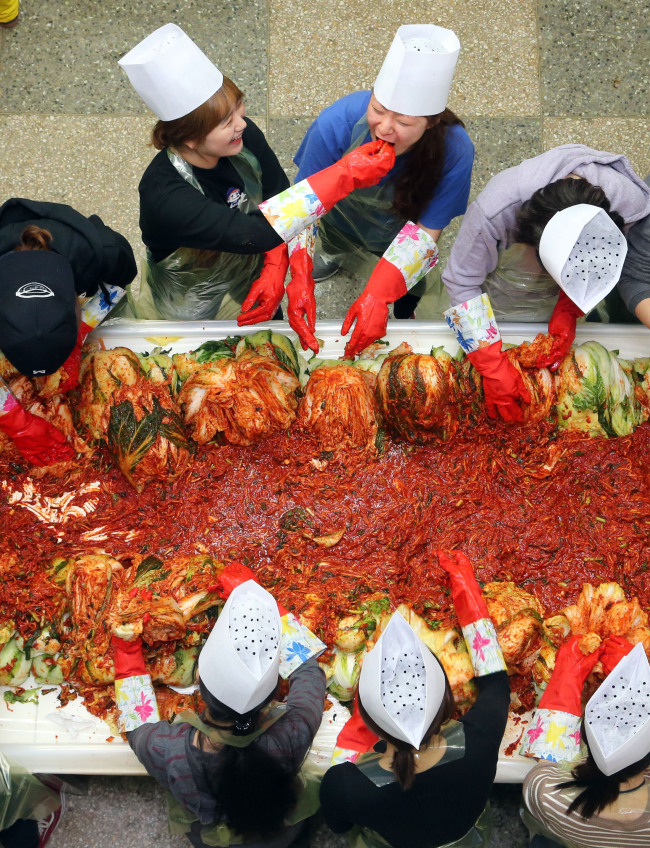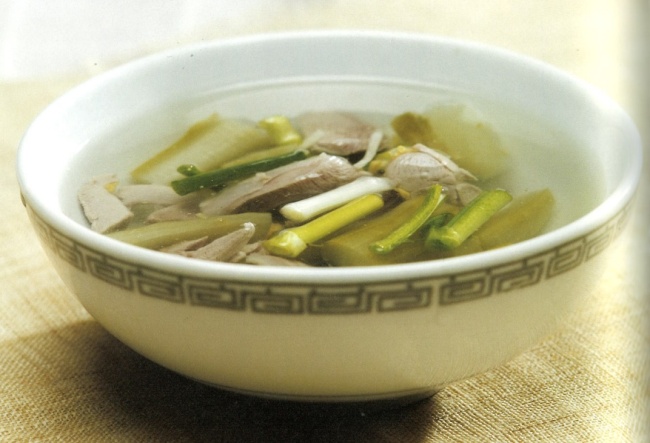Gimjang, integral part of Korean life
Long-held practice evolves with change in demographics and lifestyle
By 이우영Published : Nov. 20, 2015 - 18:02
Making kimchi, or gimjang, has long been an important family ritual for Koreans to prepare for the long and harsh winter.
Women in families gather to make kimchi based on recipes passed down from mothers to daughters and daughters-in-law through generations. It is one of the biggest family events after Chuseok and Lunar New Year’s Day, strengthening family ties and tradition.
Gimjang often involved more than just family. The whole neighborhood would come together, with villagers helping each other in the long and laborious process of making the kimchi and later sharing it.

Kimchi, a staple side dish for Koreans, means more than food. It is closely related to the Korean lifestyle and its transformation through time, becoming an indispensable part of Korean life. Its cultural and social significance put gimjang on the list of the UNESCO’s Intangible Cultural Heritage in 2013.
The first record of gimjang appears in a 13th-century book by Lee Kyu-bo, scholar of Goryeo Dynasty (A.D. 918-1392). The scholar wrote: “radish pickled in soy sauce is good for three months in summer, salted cabbage for nine months of winter” in “Gapoyukyeong,” poems on the six home garden vegetables (cucumber, eggplant, radish, green onion, curled mallow and gourd).
Original kimchi looked quite different from what we eat today. They were pickled vegetables with fewer spices. Most of us picture kimchi as salted cabbage mixed with chili pepper spices.
One of the earliest kind of kimchi from the old cookbook “Eumsik Dimibang,” written in 1672, was made without chili peppers. Instead, it featured unusual ingredients for kimchi such as pheasant meat and pepper. Typical kimchi ingredients today include garlic, ginger, chili pepper, cabbage and radish.

“The pheasant meat sounds strange today, but the kimchi had salted cucumber and pheasant meat in it, spiced with pepper,” said Cho Gwi-bun, inheritor of the cookbook and wife of the 13th-generation heir of the Seokgye Lee clan, based in Yeongyang, North Gyeongsang Province. The “Eumsik Dimibang” was written by Jang Gye-hyang, the wife of the clan’s founder.
Cho recently recreated the pheasant kimchi at a cultural event at the Korea House, Korean traditional restaurant and cultural center, in Seoul. “You will be surprised if you taste it. People loved it,” she said.
Different kimchi recipes have developed according to different climates and ingredients available in each province. There are dozens of types of kimchi popularly eaten throughout the country, including baechu kimchi (napa cabbage kimchi), dongchimi (radish water kimchi) and chonggak kimchi (radish kimchi with chili pepper).
The centuries-old culture of making kimchi is undergoing a change, however, as the size of Korean families shrink and people’s palate preferences change.
Yoon Young-mo, a 57-year-old realtor with married children, is skipping gimjang this year, and instead going to buy a small quantity of made-to-order kimchi. She had been making kimchi with her sisters-in-law and other family members for more than 30 years.
“It’s the first year I decided not to do gimjang,” said Yoon.
She used to do gimjang on weekends with relatives who come over to her house to help out and share meals together. But she began to feel that having to dedicate the weekend to making kimchi was a burden as most of them would be tired from working on weekdays.
“Buying kimchi is convenient, and it costs almost the same as making your own kimchi,” Yoon said.
This has brought a change to traditional gimjang. More people prefer to make or buy small amounts of kimchi as the ingredients become available throughout the year due to the development in farming techniques.
But the spirit of sharing kimchi continues in the changing gimjang scene.
“I’m buying more kimchi to share with my children, friends and neighbors as well,” Yoon said.
By Lee Woo-young (wylee@heraldcorp.com)








![[Graphic News] More Koreans say they plan long-distance trips this year](http://res.heraldm.com/phpwas/restmb_idxmake.php?idx=644&simg=/content/image/2024/04/17/20240417050828_0.gif&u=)
![[KH Explains] Hyundai's full hybrid edge to pay off amid slow transition to pure EVs](http://res.heraldm.com/phpwas/restmb_idxmake.php?idx=644&simg=/content/image/2024/04/18/20240418050645_0.jpg&u=20240419100350)





![[From the Scene] Monks, Buddhists hail return of remains of Buddhas](http://res.heraldm.com/phpwas/restmb_idxmake.php?idx=652&simg=/content/image/2024/04/19/20240419050617_0.jpg&u=20240419175937)

![[KH Explains] Hyundai's full hybrid edge to pay off amid slow transition to pure EVs](http://res.heraldm.com/phpwas/restmb_idxmake.php?idx=652&simg=/content/image/2024/04/18/20240418050645_0.jpg&u=20240419100350)

![[Today’s K-pop] Illit drops debut single remix](http://res.heraldm.com/phpwas/restmb_idxmake.php?idx=642&simg=/content/image/2024/04/19/20240419050612_0.jpg&u=)